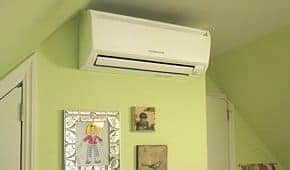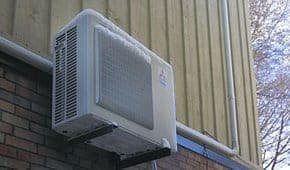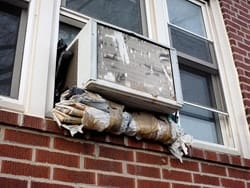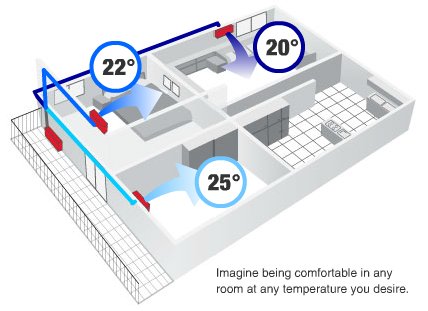More and more homeowners and businesses are using Ductless Splits for cooling. They are very common in Europe and many Canadians are not familiar with them.
A Ductless Split consists of a wall-mounted unit in your home. It’s usually mounted near the ceiling on the second floor. You also have an outdoor condenser, which can be mounted on the exterior of the building or on the ground outside. Refrigerant lines connect the two units together.
As the name implies, no ducting is required. In most homes, central air conditioning uses the furnace fan and duct system to distribute cool air. This type of system works well for heating, but is not ideal for cooling. Hot air registers are normally in the floor, because hot air rises. In the summer, cool air also has to be delivered from the floor, which is not ideal, because cool air falls.
In a two-storey home with central air, it is always difficult to keep the upper floor cool. A Ductless Split solves this problem, because the cool air is delivered at the ceiling level.
Buildings that use hot water heating through radiators or in-floor heating have no ductwork to use for central air. This is another ideal application for a Ductless Split.
Ductless Splits vs. Window Air Conditioners
Ductless Splits have many advantages over window air conditioners. They don’t block off part of your window. They don’t pose any security risk. They are quieter than a window unit. Finally, they don’t have to be stored away for the winter.
Heat Pumps
A Ductless Split can also be ordered as a heat pump, where the unit can both heat and cool. It works like an air conditioner on a warm day. The pump extracts heat from inside the home and transfer it outdoors. Conversely, on cold days the pump will flow heat energy into the home from the outside.
Unlike water, which has a boiling point of 100°C, the liquid refrigerant in a heat pump has a much lower boiling point, even lower than the cold outdoor air. This is why in heating mode, the refrigerant can still evaporate in the outdoor coil at low temperatures and draw heat from surrounding air, making the seemingly impossible heating with cold air possible. The now-heated gas refrigerant flows into the indoor coil and extracts the heat into the indoor air. Despite frigid temperatures the air will contain enough energy to heat the home, even at -30°C.
Heat Pumps are an ideal solution for a cottage. They can also compliment an existing wood, oil, propane or electric furnace. Heat Pumps are far more energy efficient than any of these heat sources and will lower your heating bills in the winter.
Multi-Head Units
It is also possible to put wall-mounted units in several rooms. They all share the same outdoor condenser. This makes is possible to have different temperatures in different rooms. You can turn off the heating or cooling in a guest room if nobody is visiting, or you can keep an exercise room at a cooler temperature.
Mitsubishi Electric
The Hayter Group is a dealer for industry leading products from Mitsubishi Electric. We service and install Mr. Slim Heat Pumps and Ductless Air Conditioning. We also offer the Zuba Central system, which replaces traditional means of heating and cooling with one quiet, compact, highly efficient, ducted system that can save space and reduce annual energy costs.





